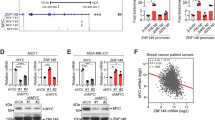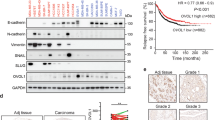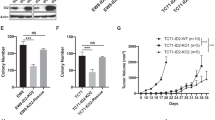Abstract
The antiproliferative activity of transforming growth factor-β (TGF-β) is essential for maintaining normal tissue homeostasis and is lost in many types of tumors. Gene responses that are central to the TGF-β cytostatic program include activation of the cyclin-dependent kinase inhibitors, p15Ink4B and p21WAF1/Cip1, and repression of c-myc. These gene responses are tightly regulated by a repertoire of transcription factors that include Smad proteins and Sp1. The DLX4 homeobox patterning gene encodes a transcription factor that is absent from most normal adult tissues, but is expressed in a wide variety of malignancies, including lung, breast, prostate and ovarian cancers. In this study, we demonstrate that DLX4 blocks the antiproliferative effect of TGF-β. DLX4 inhibited TGF-β-mediated induction of p15Ink4B and p21WAF1/Cip1 expression. DLX4 bound and prevented Smad4 from forming complexes with Smad2 and Smad3, but not with Sp1. However, DLX4 also bound and inhibited DNA-binding activity of Sp1. In addition, DLX4 induced expression of c-myc independently of TGF-β/Smad signaling. The ability of DLX4 to counteract key transcriptional control mechanisms of the TGF-β cytostatic program could explain, in part, the resistance of tumors to the antiproliferative effect of TGF-β.
This is a preview of subscription content, access via your institution
Access options
Subscribe to this journal
Receive 50 print issues and online access
$259.00 per year
only $5.18 per issue
Buy this article
- Purchase on Springer Link
- Instant access to full article PDF
Prices may be subject to local taxes which are calculated during checkout






Similar content being viewed by others
Abbreviations
- Ab:
-
antibody
- BMP:
-
bone morphogenetic protein
- DBD:
-
DNA-binding domain
- EMT:
-
epithelial-to-mesenchymal transition
- F-Luc:
-
firefly luciferase
- IP:
-
immunoprecipitation
- R-Luc:
-
Renilla luciferase
- R-Smad:
-
receptor-regulated Smad
- TGF-β:
-
transforming growth factor-β
References
Abate-Shen C . (2002). Deregulated homeobox gene expression in cancer: cause or consequence? Nat Rev Cancer 2: 777–785.
Bello-DeOcampo D, Tindall DJ . (2003). TGF-β/Smad signaling in prostate cancer. Curr Drug Targets 4: 197–207.
Berghorn KA, Clark-Campbell PA, Han L, McGrattan M, Weiss RS, Roberson MS . (2006). Smad6 represses Dlx3 transcriptional activity through inhibition of DNA binding. J Biol Chem 281: 20357–20367.
Boogerd KJ, Wong LY, Christoffels VM, Klarenbeek M, Ruijter JM, Moorman AF et al. (2008). Msx1 and Msx2 are functional interacting partners of T-box factors in the regulation of connexin43. Cardiovasc Res 78: 485–493.
Chen CR, Kang Y, Siegel PM, Massagué J . (2002). E2F4/5 and p107 as Smad cofactors linking the TGFβ receptor to c-myc repression. Cell 110: 19–32.
Chiba S, Takeshita K, Imai Y, Kumano K, Kurokawa M, Masuda S et al. (2003). Homeoprotein DLX-1 interacts with Smad4 and blocks a signaling pathway from activin A in hematopoietic cells. Proc Natl Acad Sci USA 100: 15577–15582.
Coletta RD, Christensen K, Reichenberger KJ, Lamb J, Micomonaco D, Huang L et al. (2004). The Six1 homeoprotein stimulates tumorigenesis by reactivation of cyclin A1. Proc Natl Acad Sci USA 101: 6478–6483.
Deckers M, van Dinther M, Buijs J, Que I, Löwik C, van der Pluijm G et al. (2006). The tumor suppressor Smad4 is required for transforming growth factor-β-induced epithelial-to-mesenchymal transition and bone metastasis of breast cancer cells. Cancer Res 66: 2202–2209.
Feng XH, Derynck R . (2005). Specificity and versatility in TGF-β signaling through Smads. Annu Rev Cell Dev Biol 21: 659–693.
Feng XH, Liang YY, Liang M, Zhai W, Lin X . (2002). Direct interaction of c-Myc with Smad2 and Smad3 to inhibit TGF-β-mediated induction of the CDK inhibitor p15Ink4B. Mol Cell 9: 133–143.
Feng XH, Lin X, Derynck R . (2000). Smad2, Smad3 and Smad4 cooperate with Sp1 to induce p15Ink4B transcription in response to TGF-β. EMBO J 19: 5178–5193.
Francis-Thickpenny KM, Richardson DM, van Ee CC, Love DR, Winship IM, Baguley BC et al. (2001). Analysis of the transforming growth factor-β functional pathway in epithelial ovarian carcinoma. Br J Cancer 85: 687–691.
Gartel AL, Ye X, Goufman E, Shianov P, Hay N, Najmabadi F et al. (2001). Myc represses the p21WAF1/Cip1 promoter and interacts with Sp1/Sp3. Proc Natl Acad Sci USA 98: 4510–4515.
Gemma A, Takenoshita S, Hagiwara K, Okamoto A, Spillare EA, McMemamin MG et al. (1996). Molecular analysis of the cyclin-dependent kinase inhibitor genes p15INK4B/MTS2, p16INK4/MTS1, p18 and p19 in human cancer cell lines. Int J Cancer 68: 605–611.
Haga SB, Fu S, Karp JE, Ross DD, Williams DM, Hankins WD et al. (2000). BP1, a new homeobox gene, is frequently expressed in acute leukemias. Leukemia 14: 1867–1875.
Hahn SA, Schutte M, Hoque AT, Moskaluk CA, da Costa LT, Rozenblum E et al. (1996). DPC4, a candidate tumor suppressor at human chromosome 18q21.1. Science 271: 350–353.
Hara F, Samuel S, Liu J, Rosen D, Langley R, Naora H . (2007). A homeobox gene related to Drosophila Distal-less promotes ovarian tumorigenicity by inducing expression of vascular endothelial growth factor and fibroblast growth factor-2. Am J Pathol 170: 1594–1606.
He TC, Sparks AB, Rago C, Hermeking H, Zawel L, da Costa LT et al. (1998). Identification of c-MYC as a target of the APC pathway. Science 281: 1509–1512.
Hyman E, Kauraniemi P, Hautaniemi S, Wolf M, Mousses S, Rozenblum E et al. (2002). Impact of DNA amplification on gene expression patterns in breast cancer. Cancer Res 62: 6240–6245.
Kang Y, Chen CR, Massagué J . (2003). A self-enabling TGFβ response coupled to stress signaling: Smad engages stress response factor ATF3 for Id1 repression in epithelial cells. Mol Cell 11: 915–926.
Korchynskyi O, ten Dijke P . (2002). Identification and functional characterization of distinct critically important bone morphogenetic protein-specific response elements in the Id1 promoter. J Biol Chem 277: 4883–4891.
Kusanagi K, Inoue H, Ishidou Y, Mishima H, Kawabata M, Miyazono K . (2000). Characterization of a bone morphogenetic protein-responsive Smad-binding element. Mol Cell Biol 11: 555–565.
Man YG, Fu SW, Schwartz A, Pinzone JJ, Simmens SJ, Berg PE . (2005). Expression of BP1, a novel homeobox gene, correlates with breast cancer progression and invasion. Breast Cancer Res Treat 90: 241–247.
Massagué J . (2008). TGF-β in cancer. Cell 134: 215–230.
Markowitz S, Wang J, Myeroff L, Parsons R, Sun L, Lutterbaugh J et al. (1995). Inactivation of the type II TGF-β receptor in colon cancer cells with microsatellite instability. Science 268: 1336–1338.
McGinnis W, Krumlauf R . (1992). Homeobox genes and axial patterning. Cell 68: 283–302.
Moustakas A, Heldin CH . (2005). Non-Smad TGF-β signals. J Cell Science 118: 3573–3584.
Nagatake M, Takagi Y, Osada H, Uchida K, Mitsudomi T, Saji S et al. (1996). Somatic in vivo alterations of the DPC4 gene at 18q21 in human lung cancers. Cancer Res 56: 2718–2720.
Naora H, Yang YQ, Montz FJ, Seidman JD, Kurman RJ, Roden RB . (2001). A serologically identified tumor antigen encoded by a homeobox gene promotes growth of ovarian epithelial cells. Proc Natl Acad Sci USA 98: 4060–4065.
Panganiban G, Rubenstein JL . (2002). Developmental functions of the Distal-less/Dlx homeobox genes. Development 129: 4371–4386.
Pardali K, Kurisaki A, Morén A, ten Dijke P, Kardassis D, Moustakas A . (2000). Role of Smad proteins and transcription factor Sp1 in p21Waf1/Cip1 regulation by transforming growth factor-β. J Biol Chem 275: 29244–29256.
Park GT, Morasso MI . (2002). Bone morphogenetic protein-2 (BMP-2) transactivates Dlx3 through Smad1 and Smad4: alternative mode for Dlx3 induction in mouse keratinocytes. Nucleic Acids Res 30: 515–522.
Petritsch C, Beug H, Balmain A, Oft M . (2000). TGF-β inhibits p70 S6 kinase via protein phosphatase 2A to induce G1 arrest. Genes Dev 14: 3093–3101.
Raman V, Martensen SA, Reisman D, Evron E, Odenwald WF, Jaffee E et al. (2000). Compromised HOXA5 function can limit p53 expression in human breast tumors. Nature 405: 974–978.
Reynisdóttir I, Polyak K, Iavarone A, Massagué J . (1995). Kip/Cip and Ink4 Cdk inhibitors cooperate to induce cell cycle arrest in response to TGF-β. Genes Dev 9: 1831–1845.
Samuel S, Naora H . (2005). Homeobox gene expression in cancer: insights from developmental regulation and deregulation. Eur J Cancer 41: 2428–2437.
Schutte M, Hruban RH, Hedrick L, Cho KR, Nadasdy GM, Weinstein CL et al. (1996). DPC4 gene in various tumor types. Cancer Res 56: 2527–2530.
Schwartz AM, Man YG, Rezaei MK, Simmens SJ, Berg PE . (2009). BP1, a homeoprotein, is significantly expressed in prostate adenocarcinoma and is concordant with prostatic intraepithelial neoplasia. Mod Pathol 22: 1–6.
Shen WF, Rozenfeld S, Kwong A, Köm ves LG, Lawrence HJ, Largman C . (1999). HOXA9 forms triple complexes with PBX2 and MEIS1 in myeloid cells. Mol Cell Biol 19: 3051–3061.
Shi Y, Massagué J . (2003). Mechanisms of TGF-β signaling from cell membrane to the nucleus. Cell 113: 685–700.
Siegel PM, Massagué J . (2003). Cytostatic and apoptotic actions of TGFβ in homeostasis and cancer. Nat Rev Cancer 3: 807–820.
Takenoshita S, Hagiwara K, Gemma A, Nagashima M, Ryberg D, Lindstedt BA et al. (1997). Absence of mutations in the transforming growth factor β type II receptor in sporadic lung cancers with microsatellite instability and rare H-ras1 alleles. Carcinogenesis 18: 1427–1429.
Takenoshita S, Mogi A, Tani M, Osawa H, Sunaga H, Kakegawa H et al. (1998). Absence of mutations in the analysis of coding sequences of the entire transforming growth factor-β type II receptor gene in sporadic human breast cancers. Oncol Rep 5: 367–371.
Tokunaga H, Lee DH, Kim IY, Wheeler TM, Lerner SP . (1999). Decreased expression of transforming growth factor β receptor type I is associated with poor prognosis in bladder transitional cell carcinoma patients. Clin Cancer Res 5: 2520–2525.
Tomida S, Yanagisawa K, Koshikawa K, Yatabe Y, Mitsudomi T, Osada H et al. (2007). Identification of a metastasis signature and the DLX4 homeobox protein as a regulator of metastasis by a combined transcriptome approach. Oncogene 26: 4600–4608.
Tournay O, Benezra R . (1996). Transcription of the dominant-negative helix-loop-helix protein Id1 is regulated by a protein complex containing the immediate-early response gene Egr-1. Mol Cell Biol 16: 2418–2430.
Wang D, Kanuma T, Mizunuma H, Takama F, Ibuki Y, Wake N et al. (2000). Analysis of specific gene mutations in the transforming growth factor β signal transduction pathway in human ovarian cancer. Cancer Res 60: 4507–4512.
Watanabe T, Wu TT, Catalano PJ, Ueki T, Satriano R, Haller DG et al. (2001). Molecular predictors of survival after adjuvant chemotherapy for colon cancer. N Engl J Med 344: 1196–1206.
Williams TM, Williams ME, Heaton JH, Gelehrter TD, Innis JW . (2005). Group 13 HOX proteins interact with the MH2 domain of R-Smads and modulate Smad transcriptional activation functions independent of HOX DNA-binding capability. Nucleic Acids Res 33: 4475–4484.
Woodford-Richens KL, Rowan AJ, Gorman P, Halford S, Bicknell DC, Wasan HS et al. (2001). SMAD4 mutations in colorectal cancer probably occur before chromosomal instability but after divergence of the microsatellite instability pathway. Proc Natl Acad Sci USA 98: 9719–9723.
Yamada SD, Baldwin RL, Karlan BY . (1999). Ovarian carcinoma cell cultures are resistant to TGF-β1-mediated growth inhibition despite expression of functional receptors. Gynecol Oncol 75: 72–77.
Yang X, Ji X, Shi X, Cao X . (2000). Smad1 domains interacting with Hoxc-8 induce osteoblast differentiation. J Biol Chem 275: 1065–1072.
Zawel L, Dai JL, Buckhaults P, Zhou S, Kinzler KW, Vogelstein B et al. (1998). Human Smad3 and Smad4 are sequence-specific transcription activators. Mol Cell 1: 611–617.
Acknowledgements
This work was supported by a Schissler Foundation Fellowship (B Trinh), the Vietnam Education Foundation (B Trinh), the US Department of Defense grant W81XWH-06-1-0259 (H Naora) and the National Institutes of Health grant R01 CA141078 (H Naora). We thank Sabine Thonard for technical assistance, and Song Yi Ko, Gary Gallick, Michelle Barton, Janet Price, Peng Huang and Miles Wilkinson (MD Anderson Cancer Center) for helpful discussions.
Author information
Authors and Affiliations
Corresponding author
Ethics declarations
Competing interests
Dr Naora's work has been funded by the NIH and US Department of Defense. The remaining authors declare no conflict of interest.
Additional information
Supplementary Information accompanies the paper on the Oncogene website
Rights and permissions
About this article
Cite this article
Trinh, B., Barengo, N. & Naora, H. Homeodomain protein DLX4 counteracts key transcriptional control mechanisms of the TGF-β cytostatic program and blocks the antiproliferative effect of TGF-β. Oncogene 30, 2718–2729 (2011). https://doi.org/10.1038/onc.2011.4
Received:
Revised:
Accepted:
Published:
Issue Date:
DOI: https://doi.org/10.1038/onc.2011.4
Keywords
This article is cited by
-
DNA methylation-mediated differential expression of DLX4 isoforms has opposing roles in leukemogenesis
Cellular & Molecular Biology Letters (2022)
-
TRIM22 inhibits the proliferation of gastric cancer cells through the Smad2 protein
Cell Death Discovery (2021)
-
DLX1 acts as a crucial target of FOXM1 to promote ovarian cancer aggressiveness by enhancing TGF-β/SMAD4 signaling
Oncogene (2017)
-
DLX4 hypermethylation is a prognostically adverse indicator in de novo acute myeloid leukemia
Tumor Biology (2016)
-
The homeoprotein DLX4 controls inducible nitric oxide synthase-mediated angiogenesis in ovarian cancer
Molecular Cancer (2015)



